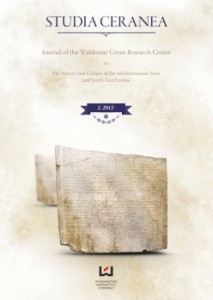A „Divine Sanction” on the Revolt: The Cult of St. Demetrios of Thessalonike and the Uprising of Peter and Asen (1185–1186)
A „Divine Sanction” on the Revolt: The Cult of St. Demetrios of Thessalonike and the Uprising of Peter and Asen (1185–1186)
Author(s): Anastasia DobyčinaSubject(s): Cultural history
Published by: Wydawnictwo Uniwersytetu Łódzkiego
Summary/Abstract: The paper examines the role of the cult of St. Demetrius of Thessalonica as a tool of maintaining legitimacy of the anti-Byzantine revolt in Tărnovo, 1185–1186, led by brothers Theodore- Peter and Asen-Belgun, which is viewed in the modern scholarship as a starting point of the history of the so-called Second Bulgarian Empire. Apart from the peculiarities of the official and popular veneration of St. Demetrius in Byzantium by the end of the 12th C., the main emphasis is made on the celebration, arranged in Tărnovo on St. Demetrius’ day, 1185, by Peter and Asen. The fact of the construction there of a special house of prayer in the name of the all-praised martyr Demetrius (Nicetas Choniates) and the presence of a certain icon of the saint as well as, probably, that of his relic, shedding the holy ointment, can be interpreted in terms of the concept of “hierotopy”, introduced recently by A. Lidov. At any rate, one can speak of attempting to replicate in Tărnovo the sacred space of the Thessalonican shrine of St. Demetrius in order to convince the Bulgarian rebels of the “true” presence of St. Demetrius among them. The parallel is drawn between the celebration in Tărnovo and another well-known “hierotopic project” of the late 12th cent., performed by prince Vsevolod III in Vladimir-on-Kljaz’ma, Russia, which also encompassed the construction of the church in the name of St. Demetrius, where his miracle- working relics from Thessalonica were housed. The similarity between the two “projects“ is obvious, but they must have been inspired by clearly different causes: if Vsevolod III tried only to raise the authority of his power to that of the grand princedom, being an absolutely legitimate ruler, then Peter and Asen had to justify the legitimacy of their own, questioning that of the Byzantine Empire.
- Issue Year: 2012
- Issue No: 2
- Page Range: 113-126
- Page Count: 14
- Language: English

